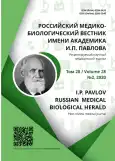Research of physical and mechanical characteristics of suture material in experiment in operations on liver
- Authors: Lipatov V.A.1, Severinov D.A.1, Denisov A.A.2, Lazarenko S.V.2, Grigor’yev N.N.2
-
Affiliations:
- Kursk State Medical University,
- Kursk State Medical University
- Issue: Vol 28, No 2 (2020)
- Pages: 193-199
- Section: Original study
- URL: https://journals.rcsi.science/pavlovj/article/view/34907
- DOI: https://doi.org/10.23888/PAVLOVJ2020282193-199
- ID: 34907
Cite item
Abstract
Taking into account the peculiarities of the blood supply to the liver and the structure of its parenchyma, and, as a result, considerable difficulties in providing reliable hemostasis without additional traumatization, a surgeon needs to be careful when performing a surgical manipulation. Despite a large number of modern methods for stopping parenchymal bleeding, many practi-tioners give preference to classic methods of hemostasis, including ligation of bleeding vessels in the bulk of the organ using specialized sutures. One of the most serious complications of the use of suture material is cutting of organ tissue, which leads to enhanced bleeding and expansion of the area of damage. At the moment, the tactics of choosing suture material for surgical procedures is empirical. In this context, the aim of this study was to assess the physico-mechanical properties of suture material regarding its structure, and to develop a criterion for choosing surgical sutures for surgical procedures. For the study, the liver was removed out of corpses of males of 35 to 40 years of age, after which separate sections of 7.5×7×4 cm in size were obtained from it. Then a wound 3 cm long and 2 cm deep was made. The wound was sutured with a simple interrupted suture without tightening, but with application of one simple half-node. For suturing, catgut, twisted capron and polyglycolide thread were used. Attention was paid to the maximal force applied at the moment of cutting (Fmax) and the degree of pulling the thread at the moment of cutting (Lu). The analysis of the data was based on comparison of Fmax and Lu parameters. This method permits to refuse from the empirical approach to the choice of suture material for operations on the liver, and to develop a criterion for choosing surgical sutures.
Full Text
##article.viewOnOriginalSite##About the authors
Vyacheslav A. Lipatov
Kursk State Medical University,
Email: d.artyom21@gmail.com
ORCID iD: 0000-0001-6121-7412
SPIN-code: 1170-1189
ResearcherId: D-8788-2013
MD, PhD, Professor, Professor of the Department of Operative Surgery and Topographic Anatomy; Head of the Experimental Surgery and Oncology Laboratory of Research Institute of Experimental Medicine
Russian Federation, KurskDmitriy A. Severinov
Kursk State Medical University,
Email: d.artyom21@gmail.com
ORCID iD: 0000-0003-4460-1353
SPIN-code: 1966-0239
ResearcherId: G-4584-2017
Assistant of the Department of Pediatric Surgery and Pediatrics at the Faculty Postgraduate Education
Russian Federation, KurskArtem A. Denisov
Kursk State Medical University
Author for correspondence.
Email: d.artyom21@gmail.com
ORCID iD: 0000-0001-5034-8580
SPIN-code: 8500-0129
ResearcherId: AE-1837-2019
Student of the Medical Faculty
Russian Federation, KurskSergey V. Lazarenko
Kursk State Medical University
Email: d.artyom21@gmail.com
ORCID iD: 0000-0002-7200-4508
SPIN-code: 1723-9128
ResearcherId: Y-9451-2018
MD, PhD, Assistant of the Department of Oncology
Russian Federation, KurskNikolay N. Grigor’yev
Kursk State Medical University
Email: d.artyom21@gmail.com
ORCID iD: 0000-0002-4102-1516
SPIN-code: 5476-4857
MD, PhD, Associate Professor, Professor of the Department of Surgical Diseases at the Faculty Postgraduate Education
Russian Federation, KurskReferences
- Açan E, Hapa O, Barber FA. Mechanical Properties of Suture Materials. In: Akgun U., Karahan M., Randelli P., et al., editors. Knots in Orthopedic Surgery. Springer, Berlin, Heidelberg; 2017. P. 21-31. doi: 10.1007/978-3-662-56108-9_3
- Vinnik YuS, Markelova NM, Shishatskaya ЕI, et al. Immunohistochemical Markers of Local Tissue Response to the Implantation of Products Made from PHA. Journal of Siberian Federal University. Biology. 2016;9(1):109-20. (In Russ). doi:10.17516/ 1997-1389-2015-9-1-109-120
- Radojkovic M, Stojkovic M, Golubovic I, et al. The influence of various microenvironmental factors on biomechanical features of different suture materials used in hepato-pancreato-biliary surgery. Facta universitatis. Series: Medicine and Biology. 2019; 21(3):95-100. doi: 10.22190/FUMB190625015R
- Severinov DA, Denisov AA, Ananjan TT. Shvy parenhimatoznyh organov: preimushhestva i nedostatki. In: Problemy gemostaza v hirurgii XXI veka; 2017 May 18-19. Kursk; 2017. P. 17-20. Available at: http://conferencinnova.ru/images/hemo2017/hemo 2017.pdf. Accessed: 2019 December 12. (In Russ).
- Zhukovskiy VА. Modern suture materials and other fiber implants. Main trend. In: Conference «Biotechnology and quality of life»; 2014 March 18-20. Moscow; 2014. P. 505-506. Available at: http:// www.spsl.nsc.ru/FullText/konfe/bio2014_tezis.pdf. Accessed: 2019 December 12. (In Russ).
- Arshakyan VA, Gynter VE, Shtofin SG, et al. Ways of improvement of surgical sutural material. ActaBiomedica Scientifica. 2017;2(6(118)):193-7. (In Russ). doi: 10.12737/article_5a0a910977eca1.04637486
- Meyer DC, Bachmann E, Lädermann A, et al. The best knot and suture configurations for high-strength suture material. An in vitro biomechanical study. Orthopaedics & Traumatology, Surgery & Research. 2018;104(8):1277-82. doi: 10.1016/j.otsr. 2018.08.010
- Zhang G., Zeng X., Su Y., et al. Influence of suture size on the frictional performance of surgical suture evaluated by a penetration friction measurement approach. Journal of the Mechanical Behavior of Biomedical Materials. 2018;80:171-9. doi:10.1016/ j.jmbbm.2018.02.003
- Lazarenko VA, Bobrovskaja EA. Biosovmestimost' v zone «protez – arterija – shovnyj material» s pozicii stenoticheskih okkljuzij posle rekonstruktivno-vosstanovitel'nyh operacij. In: Materials of the International scientific-practical conference «Medical implants»; 2016 March 18-19. Kursk; 2016. P. 71-2. Available at: http://conferencinnova. ru/images/cbooks/Sbornik_materialov_konferentsii_-_Med_ implanty_-_2016.pdf. Accessed: 2019 December 12. (In Russ).
- Abellán D, Nart J, Pascual A, et al. Cohen and others. Physical and Mechanical Evaluation of Five Suture Materials on Three Knot Configurations: An in Vitro Study. Polymers. 2016;(8):147. doi:10.3390/ polym8040147
- Johnson PC, Roberts AD, Hire JM, et al. The effect of instrumentation on suture tensile strength and knot pullout strength of common suture materials. Journal of Surgical Education. 2016;73(1):162-5. doi: 10.1016/j.jsurg.2015.08.011
- Lazarenko VA, Lipatov VA, Lazarenko SV, et al. Ustrojstvo dlja issledovanija fiziko-mehanicheskih harakteristik shvov i shovnogo materiala, stepeni deformacii parenhimy organov. Patent RUS №184617U1. 03.07.2018. Available at: https:// rusneb.ru/catalog/000224_000128_0000184617_20181101_U1_RU/. Accessed: 2019 December 12. (In Russ).
Supplementary files







